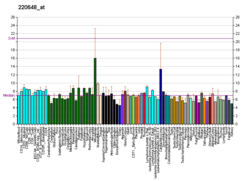ADARB2
Appearance
(Redirected from ADARB2 (gene))
| ADARB2 | |||||||||||||||||||||||||||||||||||||||||||||||||||
|---|---|---|---|---|---|---|---|---|---|---|---|---|---|---|---|---|---|---|---|---|---|---|---|---|---|---|---|---|---|---|---|---|---|---|---|---|---|---|---|---|---|---|---|---|---|---|---|---|---|---|---|
| Identifiers | |||||||||||||||||||||||||||||||||||||||||||||||||||
| Aliases | ADARB2, ADAR3, RED2, adenosine deaminase, RNA specific B2 (inactive), adenosine deaminase RNA specific B2 (inactive) | ||||||||||||||||||||||||||||||||||||||||||||||||||
| External IDs | OMIM: 602065; MGI: 2151118; HomoloGene: 10276; GeneCards: ADARB2; OMA:ADARB2 - orthologs | ||||||||||||||||||||||||||||||||||||||||||||||||||
| |||||||||||||||||||||||||||||||||||||||||||||||||||
| |||||||||||||||||||||||||||||||||||||||||||||||||||
| |||||||||||||||||||||||||||||||||||||||||||||||||||
| |||||||||||||||||||||||||||||||||||||||||||||||||||
| |||||||||||||||||||||||||||||||||||||||||||||||||||
| Wikidata | |||||||||||||||||||||||||||||||||||||||||||||||||||
| |||||||||||||||||||||||||||||||||||||||||||||||||||
Double-stranded RNA-specific editase B2 is an enzyme that in humans is encoded by the ADARB2 gene.[5][6][7]
Function
[edit]RNA-editing deaminase-2 (RED2, or ADARB2) is a member of the double-stranded RNA (dsRNA) adenosine deaminase family of RNA-editing enzymes. Adenosine deamination of pre-mRNA results in a change in the amino acid sequence of the gene product, which differs from that predicted by the genomic DNA sequence. Other members of this family include DRADA (ADAR) and RED1 (ADARB1).[5][7]
Unlike ADAR1 and ADAR2, ADAR3 has demonstrated no editing ability in vitro. It has been shown to suppress 5-HT2C RNA editing in vitro through a yet unknown mechanism, and may thus work as a negative regulator.[8]
References
[edit]- ^ a b c GRCh38: Ensembl release 89: ENSG00000185736 – Ensembl, May 2017
- ^ a b c GRCm38: Ensembl release 89: ENSMUSG00000052551 – Ensembl, May 2017
- ^ "Human PubMed Reference:". National Center for Biotechnology Information, U.S. National Library of Medicine.
- ^ "Mouse PubMed Reference:". National Center for Biotechnology Information, U.S. National Library of Medicine.
- ^ a b Mittaz L, Antonarakis SE, Higuchi M, Scott HS (Sep 1997). "Localization of a novel human RNA-editing deaminase (hRED2 or ADARB2) to chromosome 10p15". Human Genetics. 100 (3–4): 398–400. doi:10.1007/s004390050523. PMID 9272162. S2CID 13098381.
- ^ Chen CX, Cho DS, Wang Q, Lai F, Carter KC, Nishikura K (May 2000). "A third member of the RNA-specific adenosine deaminase gene family, ADAR3, contains both single- and double-stranded RNA binding domains". RNA. 6 (5): 755–67. doi:10.1017/S1355838200000170. PMC 1369955. PMID 10836796.
- ^ a b "Entrez Gene: ADARB2 adenosine deaminase, RNA-specific, B2 (RED2 homolog rat)".
- ^ Hong HQ, Lin JS, Chen L (Feb 2015). "Regulatory factors governing Adenosine-to-Inosine (A-to-I) RNA editing". Bioscience Reports. 35 (2): 1–8. doi:10.1042/BSR20140190. PMC 4381283. PMID 25662729.
External links
[edit]- Human ADARB2 genome location and ADARB2 gene details page in the UCSC Genome Browser.
Further reading
[edit]- Valenzuela A, Blanco J, Callebaut C, Jacotot E, Lluis C, Hovanessian AG, Franco R (1997). "HIV-1 Envelope gp120 and Viral Particles Block Adenosine Deaminase Binding to Human CD26". Cellular Peptidases in Immune Functions and Diseases. Advances in Experimental Medicine and Biology. Vol. 421. pp. 185–92. doi:10.1007/978-1-4757-9613-1_24. ISBN 978-1-4757-9615-5. PMID 9330696.
- Kimura K, Wakamatsu A, Suzuki Y, Ota T, Nishikawa T, Yamashita R, Yamamoto J, Sekine M, Tsuritani K, Wakaguri H, Ishii S, Sugiyama T, Saito K, Isono Y, Irie R, Kushida N, Yoneyama T, Otsuka R, Kanda K, Yokoi T, Kondo H, Wagatsuma M, Murakawa K, Ishida S, Ishibashi T, Takahashi-Fujii A, Tanase T, Nagai K, Kikuchi H, Nakai K, Isogai T, Sugano S (Jan 2006). "Diversification of transcriptional modulation: large-scale identification and characterization of putative alternative promoters of human genes". Genome Research. 16 (1): 55–65. doi:10.1101/gr.4039406. PMC 1356129. PMID 16344560.
- Andersen JS, Lam YW, Leung AK, Ong SE, Lyon CE, Lamond AI, Mann M (Jan 2005). "Nucleolar proteome dynamics". Nature. 433 (7021): 77–83. Bibcode:2005Natur.433...77A. doi:10.1038/nature03207. PMID 15635413. S2CID 4344740.
- Herrera C, Morimoto C, Blanco J, Mallol J, Arenzana F, Lluis C, Franco R (Jun 2001). "Comodulation of CXCR4 and CD26 in human lymphocytes". The Journal of Biological Chemistry. 276 (22): 19532–9. doi:10.1074/jbc.M004586200. PMID 11278278.
- Blanco J, Valenzuela A, Herrera C, Lluís C, Hovanessian AG, Franco R (Jul 2000). "The HIV-1 gp120 inhibits the binding of adenosine deaminase to CD26 by a mechanism modulated by CD4 and CXCR4 expression". FEBS Letters. 477 (1–2): 123–8. doi:10.1016/S0014-5793(00)01751-8. PMID 10899322. S2CID 22229481.
- Valenzuela A, Blanco J, Callebaut C, Jacotot E, Lluis C, Hovanessian AG, Franco R (Apr 1997). "Adenosine deaminase binding to human CD26 is inhibited by HIV-1 envelope glycoprotein gp120 and viral particles". Journal of Immunology. 158 (8): 3721–9. doi:10.4049/jimmunol.158.8.3721. PMID 9103436.
- Hillier LD, Lennon G, Becker M, Bonaldo MF, Chiapelli B, Chissoe S, Dietrich N, DuBuque T, Favello A, Gish W, Hawkins M, Hultman M, Kucaba T, Lacy M, Le M, Le N, Mardis E, Moore B, Morris M, Parsons J, Prange C, Rifkin L, Rohlfing T, Schellenberg K, Bento Soares M, Tan F, Thierry-Meg J, Trevaskis E, Underwood K, Wohldman P, Waterston R, Wilson R, Marra M (Sep 1996). "Generation and analysis of 280,000 human expressed sequence tags". Genome Research. 6 (9): 807–28. doi:10.1101/gr.6.9.807. PMID 8889549.





